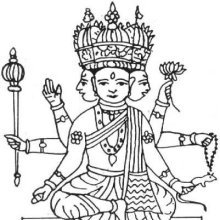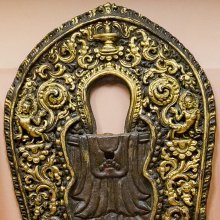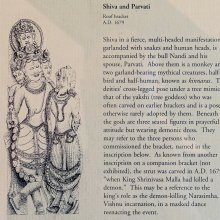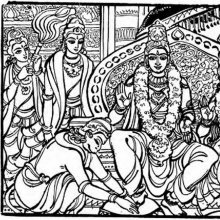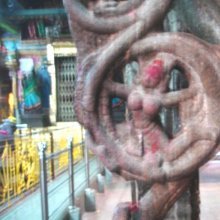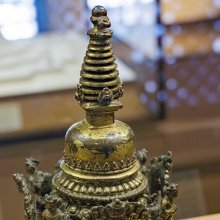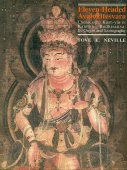Kinnara, Kiṃnara, Kinnarā, Kiṃnarā: 35 definitions
Introduction:
Kinnara means something in Buddhism, Pali, Hinduism, Sanskrit, Jainism, Prakrit, Marathi, Hindi. If you want to know the exact meaning, history, etymology or English translation of this term then check out the descriptions on this page. Add your comment or reference to a book if you want to contribute to this summary article.
Alternative spellings of this word include Kinnar.
Images (photo gallery)
In Hinduism
Purana and Itihasa (epic history)
Source: archive.org: Puranic EncyclopediaKinnara (किन्नर).—A sect of Devas all of whom hold Vīṇās in their hands. (Agni Purāṇa, Chapter 51).
Source: archive.org: Shiva Purana - English TranslationKinnara (किन्नर), like Yakṣas, are the attendants of Kubera. They are represented as mythical beings with a human figure and the head of a horse or with a horse’s body and the head of a man. They are described as celestial choristers and musicians who dwell in the paradise of Kuvera on Kailāsa. They are called Aśvamukhas, Turaṅgavaktras, “horse-faced” and Mayus.
Source: Cologne Digital Sanskrit Dictionaries: The Purana Index1a) Kinnara (किन्नर).—The son of Sunakṣatra, and father of Antarikṣa.*
- * Vāyu-purāṇa 99. 285; IV. 22. 4-5.
1b) A group of divine singers.1 Born of Brahmā's shadow; these frequent Kailāsa;2 celebrate Puruṣa, Indra and Hari.3 Went to Dvārakā to see Kṛṣṇa,4 and learnt the dharma from the seven sages;5 worship pitṛs.6
- 1) Bhāgavata-purāṇa II. 10. 38.
- 2) Ib. III. 20. 45; IV. 6. 9; Brahmāṇḍa-purāṇa II. 25. 28; III. 7. 176; 8. 71.
- 3) Bhāgavata-purāṇa IV. 30. 6; VI. 7. 4; VII. 8. 38; X. 3. 6; 4. 11.
- 4) Ib. XI. 6. 3.
- 5) Ib. XI. 14. 6; 31-2.
- 6) Brahmāṇḍa-purāṇa III. 10. 38 and 111; 22. 59; 37. 19; IV. 20. 49; 33. 27; 39. 56.
1c) Born of Ariṣṭā and Kaśyapa: Citraratha is their overlord. Live in Himālayas; help Indra; kingdom of.*
- * Matsya-purāṇa 6. 45; 8. 6; 13. 16; 23. 39; 117. 8; 121. 48; 148. 92.
1d) Sons of Aśvamukhas; had a number of gaṇas, horse-faced and human-faced; famous for dancing and music;1 servants in Śivapura;2 live in the Mahānīla hill;3 hundred cities of, in Kailāsa.4
Source: JatLand: List of Mahabharata people and placesKiṃnara (किंनर) is a name mentioned in the Mahābhārata (cf. I.60.7) and represents one of the many proper names used for people and places. Note: The Mahābhārata (mentioning Kiṃnara) is a Sanskrit epic poem consisting of 100,000 ślokas (metrical verses) and is over 2000 years old.

The Purana (पुराण, purāṇas) refers to Sanskrit literature preserving ancient India’s vast cultural history, including historical legends, religious ceremonies, various arts and sciences. The eighteen mahapuranas total over 400,000 shlokas (metrical couplets) and date to at least several centuries BCE.
Vaishnavism (Vaishava dharma)
Source: Pure Bhakti: Bhagavad-gita (4th edition)Kinnara (किन्नर) refers to “a kind of demigod who plays musical instruments and sings with the Gandharvas”. (cf. Glossary page from Śrīmad-Bhagavad-Gītā).

Vaishnava (वैष्णव, vaiṣṇava) or vaishnavism (vaiṣṇavism) represents a tradition of Hinduism worshipping Vishnu as the supreme Lord. Similar to the Shaktism and Shaivism traditions, Vaishnavism also developed as an individual movement, famous for its exposition of the dashavatara (‘ten avatars of Vishnu’).
Shilpashastra (iconography)
Source: Shodhganga: Elements of Art and Architecture in the Trtiyakhanda of the Visnudharmottarapurana (shilpa)Kinnara (किन्नर) refers to a certain class of personalities which follows specific guidelines in the tradition of ancient Indian Painting (citra), according to the Viṣṇudharmottarapurāṇa, an ancient Sanskrit text which (being encyclopedic in nature) deals with a variety of cultural topics such as arts, architecture, music, grammar and astronomy.—In the Viṣṇudharmottarapurāṇa, the rules of Painting of different classes have been elaborately discussed. According to this work, the size of [e.g., Kinnaras], [...] in a picture should be equal to the size of mālyava type of men. The Yakṣas and the Kinnaras presuppose a divine connection in their birth. The reference of two kinds of Kinnaras are found. Some have the faces of human and the bodies of horse and some are totally opposite of it. Thus the Viṣṇudharmottarapurāṇa establishes the fact that even in the pictures; the people belonging to different class and profession [e.g., Kinnara] were projected with specific attire so that general people can equate the picture with the practical character.

Shilpashastra (शिल्पशास्त्र, śilpaśāstra) represents the ancient Indian science (shastra) of creative arts (shilpa) such as sculpture, iconography and painting. Closely related to Vastushastra (architecture), they often share the same literature.
General definition (in Hinduism)
Source: WikiPedia: Hinduism1) In Buddhist mythology and Hindu mythology, a kinnara is a paradigmatic lover, a celestial musician, half-human and half-horse (India) or half-bird (south-east Asia). Their character is clarified in the Adi parva of the Mahabharata, where they say:
We are everlasting lover and beloved. We never separate. We are eternally husband and wife; never do we become mother and father. No offspring is seen in our lap. We are lover and beloved ever-embracing. In between us we do not permit any third creature demanding affection. Our life is a life of perpetual pleasure.
They are also featured in a number of Buddhist texts, including the Lotus Sutra. An ancient Indian string instrument is known as the Kinnari Veena.
2) In Southeast Asian mythology, Kinnaris, the female counterpart of Kinnaras, are depicted as half-bird, half-woman creatures. One of the many creatures that inhabit the mythical Himavanta. Kinnaris have the head, torso, and arms of a woman and the wings, tail and feet of a swan. She is renowned for her dance, song and poetry, and is a traditional symbol of feminine beauty, grace and accomplishment.
3) In Cambodia, the kinnaras are known in the Khmer language as kenar. The female counterpart, the kinnari, are depicted in Cambodian art and literature more often than the male counterparts.
4) In Tibet the Kinnara is known as the 'shang-shang' (ཤང་ཤང; Sanskrit: civacivaka). This chimera is depicted either with just the head or including the whole torso of a human including the arms with the lower body as that of a winged bird. In Nyingma Mantrayana traditions of Mahayoga Buddhadharma, the shang-shang symbolizes 'enlightened activity' (Wylie: phrin las).
In Buddhism
Theravada (major branch of Buddhism)
Source: Pali Kanon: Pali Proper NamesWife of Kandari, king of Benares. See Kandari Jataka.
Theravāda is a major branch of Buddhism having the the Pali canon (tipitaka) as their canonical literature, which includes the vinaya-pitaka (monastic rules), the sutta-pitaka (Buddhist sermons) and the abhidhamma-pitaka (philosophy and psychology).
Mahayana (major branch of Buddhism)
Source: Wisdom Library: Maha Prajnaparamita SastraKiṃnara (किंनर) refers to “divine artists” depending on the gods according to the 2nd century Mahāprajñāpāramitāśāstra (chapter XV). Accordingly, “The Kiṃnaras also are divine artists who depend on the gods. Gandharvas and Kiṃnaras habitually reside in two places: their usual residence is on the Ten-Jewel Mountain (daśaratnagiri); but sometimes in the heavens, they play music for the gods. These two types of beings are not subject to the alternations of high and low”.
Kiṃnaras, together with other deities constitute the Asuras, according to chapter XLVI.—Accordingly, “great gods such as the Asuras, Kiṃnaras, Gandharvas, Kumbhāndas, Yakṣas, Rakṣasas, Bhūtas, etc., are Asuras, and when their troops increase, those of the Devas decrease. Their power (anubhāva) and their transformations (nirmāṇa) were exercised at will. The Asura destiny is called thus because the Asuras appear at the head of a list; the others, namely, the Kiṃnaras, Gandharvas, Kuṃbhāṇḍas, Yakṣas, Bhūtas, etc. constitute one and the same destiny with them”.
Source: archive.org: Bulletin of the French School of the Far East (volume 5)Kinnara (किन्नर) (in Chinese: Kin-na-lo) refers to one of the fifty-five kingdoms enumerated in chapter 17 of the Candragarbha: the 55th section of the Mahāsaṃnipāta-sūtra, a large compilation of Sūtras (texts) in Mahāyāna Buddhism partly available in Sanskrit, Tibetan and Chinese.—In the Candragarbhasūtra, the Bhagavat invites all classes of Gods and Deities to protect the Law [dharma?] and the faithful in their respective districts.—In Kinnara, the following deities are appointed (among others): The Kumbhāṇḍa Acala.
Kinnara (किन्नर) (in Chinese: Kin-na-lo) is the name of an ancient kingdom associated with Revatī or Revatīnakṣatra, as mentioned in chapter 18.

Mahayana (महायान, mahāyāna) is a major branch of Buddhism focusing on the path of a Bodhisattva (spiritual aspirants/ enlightened beings). Extant literature is vast and primarely composed in the Sanskrit language. There are many sūtras of which some of the earliest are the various Prajñāpāramitā sūtras.
Tibetan Buddhism (Vajrayana or tantric Buddhism)
Source: Wisdom Library: Tibetan BuddhismKinnara (किन्नर) refers to a group of deities summoned by the Yamāntaka-mantra and mentioned as attending the teachings in the 6th century Mañjuśrīmūlakalpa: one of the largest Kriyā Tantras devoted to Mañjuśrī (the Bodhisattva of wisdom) representing an encyclopedia of knowledge primarily concerned with ritualistic elements in Buddhism. The teachings in this text originate from Mañjuśrī and were taught to and by Buddha Śākyamuni in the presence of a large audience (including Kinnara).
Source: archive.org: The Indian Buddhist IconographyKinnara (किन्नर) refers to a group of deities commonly depicted in Buddhist Iconography, and mentioned in the 11th-century Niṣpannayogāvalī of Mahāpaṇḍita Abhayākara.—The Kinnara king is reddish-white in colour and is engaged inplaying on the musical instrument called the vīṇā.
Source: academia.edu: The Structure and Meanings of the Heruka MaṇḍalaKinnara (किन्नर) is the name of a Vīra (hero) who, together with the Ḍākinī named Kinnarī forms one of the 36 pairs situated in the Ākāśacakra, according to the 10th century Ḍākārṇava chapter 15. Accordingly, the ākāśacakra refers to one of the three divisions of the dharma-puṭa (‘dharma layer’), situated in the Herukamaṇḍala. The 36 pairs of Ḍākinīs and Vīras [viz., Kinnara] are dark blue in color; they each have one face and four arms; they hold a skull bowl, a skull staff, a small drum, and a knife.

Tibetan Buddhism includes schools such as Nyingma, Kadampa, Kagyu and Gelug. Their primary canon of literature is divided in two broad categories: The Kangyur, which consists of Buddha’s words, and the Tengyur, which includes commentaries from various sources. Esotericism and tantra techniques (vajrayāna) are collected indepently.
General definition (in Buddhism)
Source: Wisdom Library: BuddhismKimnara:—A heavenly being with a beautiful voice that protects Dharma practitioners.
In Jainism
General definition (in Jainism)
Source: Wisdom Library: JainismKiṃnara (किंनर).—The kiṃnaras (or, kinnaras) are a group of deities categorised as belonging to the vyantara class of Gods (devas). The vyantaras represent a class of Gods (devas) comprising eight groups of deities that wander about the three worlds (adhaloka, madhyaloka and ūrdhvaloka).
Source: Google Books: Jaina IconographyKinnara (किन्नर).—A class of vyantara gods;—According to the Tiloyapaṇṇatti they are divided into nine classes:
- Kinnara,
- Kimpuruṣa,
- Hṛdayaṅgama,
- Rūpapāli,
- Kinnarakinnara,
- Anindita,
- Manorama,
- Kinnarottama,
- Ratipriya.
They are all black. Aśoka is the Caitya-tree of these gods.
According to Śvetāmbaras they are of ten kinds:
- Kinnara,
- Kimpuruṣa,
- Kimpuruṣottama,
- Kinnarottama,
- Hṛdayaṅgama,
- Rūpaśāli,
- Anindita,
- Manorama,
- Ratipriya,
- Ratiśreṣṭha.
Black in complexion, they have especially charming faces, they wear crowns and have a peaceful appearance. Aśoka tree is their flag mark.
Source: archive.org: The Jaina IconographyKinnara (किन्नर) is the name of the Yakṣa accompanying Dharmanātha: the fifteenth of twenty-four Tīrthaṃkaras or Jinas, commonly depicted in Jaina iconography.—The symbol by which an image of Dharmanātha is to be recognised is Vajradaṇḍa or thunder-bolt. The Yakṣa couple to attend upon him are respectively called Kinnara and Kandarpā (Digambara Mānasī). The position of a fanner has been taken up by Puṇḍarīka-Vāsudeva. The Kevala tree for him is called Dadhiparṇa or Saptacchada.
The texts of both the schools is unanimous in giving this [Kinnara] Yakṣa three faces and six arms. His vehicle differs from a tortoise with the Śvetāmbaras to a fish with the Digambaras. The former sect describes his attributes as a citrus, mace, Abhaya, mongoose, lotus and a rosary. The Digambaras, on the contrary, describe them as a disc, Vajra, goad, club, rosary and Vara Mudrā.
Source: archive.org: Trisastisalakapurusacaritra1) Kinnara (किन्नर) and Kimpuruṣa are the two Indras (i.e., lords or kings) of the Kinnaras who came to the peak of Meru for partaking in the birth-ceremonies of Ṛṣabha, according to chapter 1.2 [ādīśvara-caritra] of Hemacandra’s 11th century Triṣaṣṭiśalākāpuruṣacaritra: an ancient Sanskrit epic poem narrating the history and legends of sixty-three illustrious persons in Jainism.
2) Kinnara (किन्नर) is the name of a Yakṣa (i.e., Śāsanadevatās or ‘messenger-deities’) associated with Dharma-nātha, according to chapter 4.5 [dharmanātha-caritra].—Accordingly:—“Originating in that congregation, Kinnara, three-faced, with a tortoise for a vehicle, red in color, resplendent with right hands holding a citron and a club, and with one in the position bestowing fearlessness; and with left hands encircled with an ichneumon, lotus, and rosary, became Dharmanātha’s messenger-deity. Likewise originated, Kandarpā, fair in body, with a fish for a vehicle, adorned with right hands carrying a blue night-blooming lotus and goad, and with one left hand carrying a lotus and one in the position bestowing fearlessness, became the Lord’s messenger-deity always near at hand”.
Source: Encyclopedia of Jainism: Tattvartha Sutra 4: The celestial beings (deva)Kinnara (किन्नर) refers to the “music-obsessed” class of “peripatetic celestial beings” (vyantara), itself a category of devas (celestial beings), according to the 2nd-century Tattvārthasūtra 4.10. Who are the lords amongst the music-obsessed (kinnara) class of peripatetic (forest) celestial beings? Kinnara and Kimpuruṣa are the two lords in the music obsessed peripatetic celestial beings.

Jainism is an Indian religion of Dharma whose doctrine revolves around harmlessness (ahimsa) towards every living being. The two major branches (Digambara and Svetambara) of Jainism stimulate self-control (or, shramana, ‘self-reliance’) and spiritual development through a path of peace for the soul to progess to the ultimate goal.
Languages of India and abroad
Pali-English dictionary
Source: BuddhaSasana: Concise Pali-English Dictionarykinnara : (m.) a bird with a human head; name of a forest dwelling nation.
Source: Sutta: The Pali Text Society's Pali-English DictionaryKinnara, (kiṃ+nara, lit. what-man, see kiṃ 3) a little bird with a head like a man’s) J. IV, 106, 254, 438, V. 47, 456; Mil 267. Canda kinnara Np. J. I, 91, VI, 283, VI, 74. ‹-› f. kinnarā Np. of a queen J. V, 437 sq. , and kinnarī Th. 2, 381 (cp. ThA. 255), J. II, 121 (matta-kinnarī viya), 230; IV, 432 sq. Cp. kimpurisa. (Page 215)

Pali is the language of the Tipiṭaka, which is the sacred canon of Theravāda Buddhism and contains much of the Buddha’s speech. Closeley related to Sanskrit, both languages are used interchangeably between religions.
Marathi-English dictionary
Source: DDSA: The Molesworth Marathi and English Dictionarykinnara (किन्नर).—m S A celestial chorister or musician.
Source: DDSA: The Aryabhusan school dictionary, Marathi-Englishkinnara (किन्नर).—m A celestial musician.
Marathi is an Indo-European language having over 70 million native speakers people in (predominantly) Maharashtra India. Marathi, like many other Indo-Aryan languages, evolved from early forms of Prakrit, which itself is a subset of Sanskrit, one of the most ancient languages of the world.
Sanskrit dictionary
Source: DDSA: The practical Sanskrit-English dictionaryKinnara (किन्नर).—See under किम् (kim). 1 kim ind. Used for कु (ku) only at the beginning of comp. to convey the senses of 'badness', 'deterioration', 'defect', 'blame' or 'censure'; e. g. किंसखा (kiṃsakhā) a bad friend; किन्नरः (kinnaraḥ) a bad or deformed man &c.; see comp. below.
Source: Cologne Digital Sanskrit Dictionaries: Edgerton Buddhist Hybrid Sanskrit DictionaryKiṃnara (किंनर).—name of a yakṣa: Mahā-Māyūrī 40.
Source: Cologne Digital Sanskrit Dictionaries: Shabda-Sagara Sanskrit-English DictionaryKinnara (किन्नर).—m.
(-raḥ) 1. A demigod attached to the service of Kuvera, a celestial quirister or musician. 2. A kind of flower or attendant on a Jina or Jaina saint. f. (-rī) A female Kinnara, or chorister. E. kiṃ what, used contemptuously, (what kind of) nara a man: the Kinnara having, with the human figure, the head of a horse.
Source: Cologne Digital Sanskrit Dictionaries: Benfey Sanskrit-English DictionaryKiṃnara (किंनर).—i. e. kim-nara, m. and f. rī, A class of demigods attached to the service of Kuvera, [Mānavadharmaśāstra] 1, 39. 2. A proper name, [Rājataraṅgiṇī] 1, 197.
Source: Cologne Digital Sanskrit Dictionaries: Cappeller Sanskrit-English DictionaryKiṃnara (किंनर).—[masculine] a class of mythical beings (half man half animal).
Source: Cologne Digital Sanskrit Dictionaries: Monier-Williams Sanskrit-English Dictionary1) Kiṃnara (किंनर):—[=kiṃ-nara] a etc. See kim.
2) [=kiṃ-nara] [from kiṃ > kim] b m. ‘what sort of man?’ a mythical being with a human figure and the head of a horse (or with a horse’s body and the head of a man, [Śiśupāla-vadha iv, 38]; originally perhaps a kind of monkey cf. vā-nara; in later times (like the Naras) reckoned among the Gandharvas or celestial choristers, and celebrated as musicians; also attached to the service of Kubera; (with Jains) one of the eight orders of the Vyantaras), [Manu-smṛti; Mahābhārata] etc.
3) [v.s. ...] Name of a prince, [Viṣṇu-purāṇa]
4) [v.s. ...] of Nara (a son of Vibhīṣaṇa), [Rājataraṅgiṇī i, 197]
5) [v.s. ...] of the attendant of the fifteenth Arhat of the present Avasarpiṇī, [Jaina literature]
6) [v.s. ...] Name of a locality [gana] takṣaśilādi
7) Kiṃnarā (किंनरा):—[=kiṃ-narā] [from kiṃ-nara > kiṃ > kim] f. a kind of musical instrument, [cf. Lexicographers, esp. such as amarasiṃha, halāyudha, hemacandra, etc.] (cf. κινύρα)
Source: Cologne Digital Sanskrit Dictionaries: Yates Sanskrit-English DictionaryKinnara (किन्नर):—[kinna-ra] (raḥ) 1. m. A demigod in the service of Kuvera. f. (rī) a demigoddess; a celestial musician.
Source: DDSA: Paia-sadda-mahannavo; a comprehensive Prakrit Hindi dictionary (S)Kinnara (किन्नर) in the Sanskrit language is related to the Prakrit word: Kiṃnara.
[Sanskrit to German]
Sanskrit, also spelled संस्कृतम् (saṃskṛtam), is an ancient language of India commonly seen as the grandmother of the Indo-European language family (even English!). Closely allied with Prakrit and Pali, Sanskrit is more exhaustive in both grammar and terms and has the most extensive collection of literature in the world, greatly surpassing its sister-languages Greek and Latin.
Hindi dictionary
Source: DDSA: A practical Hindi-English dictionaryKinnara (किन्नर) [Also spelled kinnar]:—(nm) a mythical being with human figures and a head of horse or with a horse’s body and the head of a man; a race celebrated as musicians.
...
Prakrit-English dictionary
Source: DDSA: Paia-sadda-mahannavo; a comprehensive Prakrit Hindi dictionaryKiṃnara (किंनर) in the Prakrit language is related to the Sanskrit word: Kinnara.
Prakrit is an ancient language closely associated with both Pali and Sanskrit. Jain literature is often composed in this language or sub-dialects, such as the Agamas and their commentaries which are written in Ardhamagadhi and Maharashtri Prakrit. The earliest extant texts can be dated to as early as the 4th century BCE although core portions might be older.
Kannada-English dictionary
Source: Alar: Kannada-English corpusKinnara (ಕಿನ್ನರ):—
1) [noun] a male member of the category of mythical beings in human form with the head of a horse.
2) [noun] the constellation Centaurus, between Hydra and Crux, containing Alpha Centauri.
Kannada is a Dravidian language (as opposed to the Indo-European language family) mainly spoken in the southwestern region of India.
See also (Relevant definitions)
Partial matches: Kiṇṇa, Kim, Nara, Ra.
Starts with (+11): Kimnarapura, Kinnara Jataka, Kinnara Kingdom, Kinnarabhave, Kinnaraccurai, Kinnaradasa, Kinnarageya, Kinnaragita, Kinnaraja, Kinnarakam, Kinnarakanti, Kinnarakathe, Kinnarakinnara, Kinnaranara, Kinnarapada, Kinnarapashrni, Kinnarapati, Kinnarappetti, Kinnaraprabhu, Kinnarapriya.
Ends with: Kinnarakinnara, Mahakinnara, Prakkinnara, Sarvakimnara.
Full-text (+390): Gitamodin, Kimnarakantha, Mahadharma, Ashvamukha, Drumaratnashakhaprabha, Kimpurusha, Martyamukha, Surenupushpadhvaja, Bhushanendraprabha, Manidharini, Drumakimnararaja, Turangavaktra, Kusumaketumandalin, Prahasita, Druma, Ratnakiritin, Kimnaranagara, Mayu, Kimnarapati, Yoganugata.
Relevant text
Search found 101 books and stories containing Kinnara, Kiṃnara, Kinnarā, Kiṃnarā, Kimnara, Kim-nara, Kiṃ-nara, Kiṃ-narā, Kinna-ra, Kiṇṇara; (plurals include: Kinnaras, Kiṃnaras, Kinnarās, Kiṃnarās, Kimnaras, naras, narās, ras, Kiṇṇaras). You can also click to the full overview containing English textual excerpts. Below are direct links for the most relevant articles:
Garga Samhita (English) (by Danavir Goswami)
Verse 5.8.45 < [Chapter 8 - The Killing of Kaṃsa]
Verse 3.4.10 < [Chapter 4 - The Coronation-Bathing of Śrī Kṛṣṇa]
Verse 1.16.36 < [Chapter 16 - Description of Śrī Rādhikā’s Wedding]
Maha Prajnaparamita Sastra (by Gelongma Karma Migme Chödrön)
Story of druma’s action on the śrāvakas < [Part 5 - The virtue of meditation]
Appendix 7 - The Legend of Druma (king of the Gandharvas) < [Chapter XV - The Arrival of the Bodhisattvas of the Ten Directions]
II. Beings to be established in the six perfections < [Part 3 - Establishing beings in the six perfections]
Village Folk-tales of Ceylon (Sri Lanka), vol. 1-3 (by Henry Parker)
Story 34 - The Kinnara and the Parrots < [Part I - Stories told by the Cultivating Caste and Vaeddas]
Part II (e) - Stories of the Kinnaras
Story 75 - The Crocodile And The Jackal < [Part II (e) - Stories of the Kinnaras]
Vishnudharmottara Purana (Art and Architecture) (by Bhagyashree Sarma)
7(b): Portrait of Different Classes Projected in Painting < [Chapter 5 - Painting and Image Making]
2. Origin and Development of Indian Music < [Chapter 2 - Music]
8(b): The Image of Various Gods < [Chapter 5 - Painting and Image Making]
Trishashti Shalaka Purusha Caritra (by Helen M. Johnson)
Part 19: The Vyantaras < [Chapter III - The initiation and omniscience of Ajita]
Part 19: Dharmanātha’s śāsanadevatās (messenger-deities) < [Chapter V - Śrī Dharmanāthacaritra]
Part 30: Tripṛṣṭha and the musicians < [Chapter I - Śreyāṃsanāthacaritra]
The Mahavastu (great story) (by J. J. Jones)
Chapter XIII - The Kinnarī Jātaka < [Volume II]
Chapter VII - The ten Bhūmis < [Volume I]
Chapter XXVII - Jātaka of Surūpa (king of the deer) < [Volume II]
Related products
